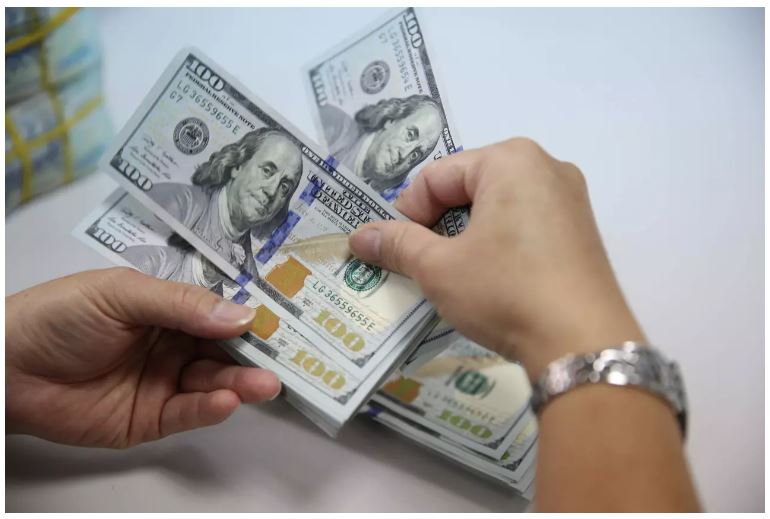Vietnam: A tall order
The Vietnamese dong currency remains remarkably stable while other currencies are sliding against the U.S. dollar. This situation makes foreign exchange rate management increasingly difficult. Foreign exchange rate under pressure.
Foreign exchange rate under pressure
Only 53 days after a VND200 per dollar hike, the selling price of the greenback on July 4 was adjusted up by a further VND150 by the State Bank of Vietnam (SBV), leaving the dong-dollar exchange rate at VND23,400. Dollars are now traded via spot contracts, instead of three-month forward deals as earlier.
On the morning of July 18, the central exchange rate quoted by the SBV inched up by VND20 to VND23,245 per dollar. Thus, in the first half of July, the rate inched up by a total of VND135, a markedly rapid increase in recent years.
The dollar prices at commercial banks have also edged up by VND180-200 since the beginning of July. Compared to early this year, they have leapt by VND670-700, equivalent to nearly 3%, much higher than the addition of just more than 40 basis points to the central exchange rate.
The volatility of the exchange rate on the formal market has sent dollar prices on the informal market soaring, with the buying price officially surpassing the VND24,500 per U.S. dollar mark in mid-July. Moreover, the gap between selling and buying prices is the widest in years, at VND150. In comparison with late June, the price of the dollar on the informal market has picked up nearly VND600 for buying and VND700 for selling, and VND1,000 and VND1,120 compared to the start of the year, equivalent to 4.3% and 4.8%.
On global markets, the USD Index on July 14 briefly hit its 20-year high. Thus, the spike in the exchange rate at home is still insignificant as compared with the movements of the dollar on world markets, and with the falls of many other currencies in the region and other hard currencies such as the euro, the Australian dollar and the Japanese yen. For example, the exchange rate between the euro and the U.S. dollar on July 14 once fell below one, down more than 12% against early this year.
Concerns about a recession, global supply chain disruptions and economic stagnation in Europe due to the Russian-Ukrainian military conflict, plus the hawkish monetary policy stance of the U.S. Federal Reserve (Fed) are sending the dollar rising.
After three interest rate hikes this year with a total of 1.5 percentage points, the highest in decades, the Fed hiked the federal funds rate by 75 basis points at its meeting on July 27. The consumer price index (CPI) stateside in June shot up 9.1% over the same period last year and this was the highest inflation rate in the U.S. in more than 40 years, much higher than the rate of 8.6% recorded in May.
Tough choices
The dong has remained remarkably stable though other currencies have been falling against the dollar. This is due to the recent interventions by the central bank.
In previous years, the SBV bought considerable volumes of foreign currency, thus increasing the nation’s foreign exchange reserves. Since the start of 2022, the central bank has injected US$12-13 billion into the system to help stabilize the exchange rate, especially over the past month. The central bank has kept withdrawing dong funds from the economy through T-bill issues, narrowing the difference in interest rates between the U.S. dollar and the dong, thereby helping stabilize the local currency.
How to manage the exchange rate properly is very difficult. If the dong tumbles too quickly, it would increase inflationary pressure, which might make the inflation target for this year unobtainable.
On the contrary, an excessive intervention in the foreign exchange market is no good for Vietnam’s foreign trade, as it makes the country’s exports less competitive than other economies whose currencies have dropped sharply against the dollar since early this year. Such a policy may significantly spur imports and eventually result in a huge trade deficit. In the first half of 2022, Vietnam achieved a trade surplus of US$710 million, only 18% of the figure of more than US$4 billion recorded in 2021.
Looking at the recent moves by the central bank, the stabilization of the exchange rate is prioritized.
Consumer prices have been skyrocketing worldwide. Vietnam’s economy has a high level of openness and heavily depends on imports of fuels and raw materials, so it is essential to keep the exchange rate stable to prevent input prices from rising.
Data from the General Statistics Office indicated the import price index in the second quarter of 2022 picked up 2.62% against the preceding quarter and 11.43% over the same period last year. The total index increase in the first six months of the year was 11.21%, much higher than the 5.49% in 2021. On the contrary, the export price index rose 3.31% against the first quarter and only 8.56% year-on-year, taking the six-month increase to just 8.03%.
Strong rises in the prices of fuels and raw materials will inevitably affect producers and economic growth. The economy is still in the early stages of post-Covid recovery and a global recession is looming.
The prices of local products will then shoot up in proportion to higher input costs, exerting more pressure on inflation and interest rates. Meanwhile, at a conference to review banking sector operations in the first six months and discuss tasks for the rest of the year on July 15, the SBV hinted at bringing down interest rates by 0.5-1 percentage point.
Therefore, keeping the exchange rate stable will help accomplish multiple objectives, not only stabilizing the dong but also making sure business and production activities will go uninterrupted, reining in inflation and keeping interest rates for the dong steady.
Source: SGT


 English
English




